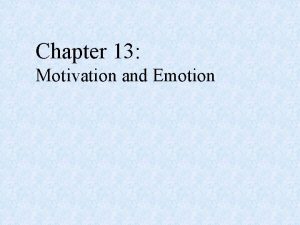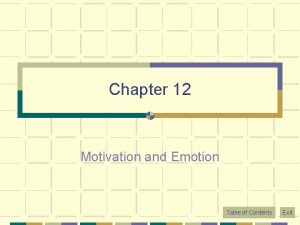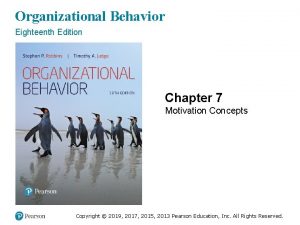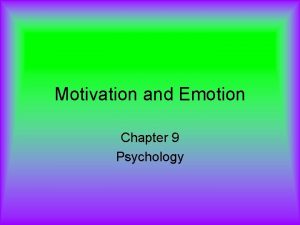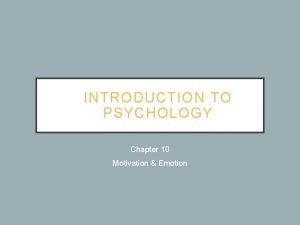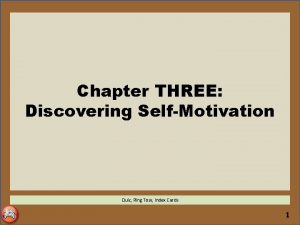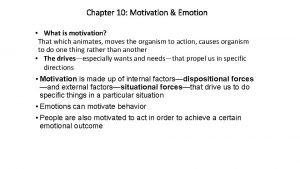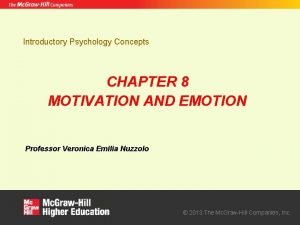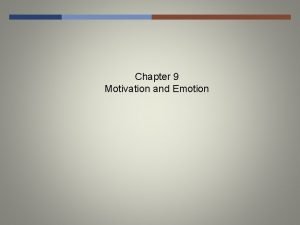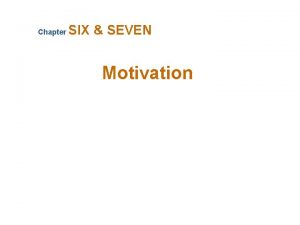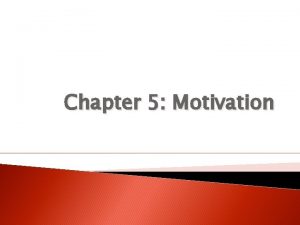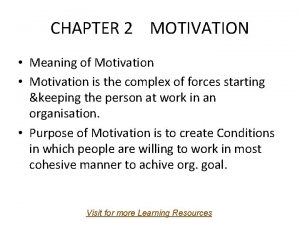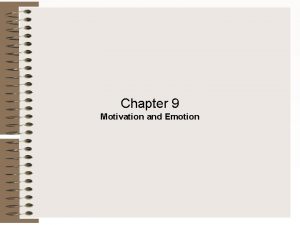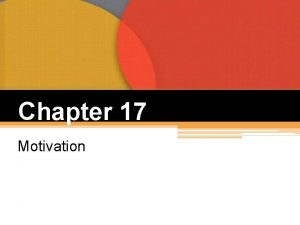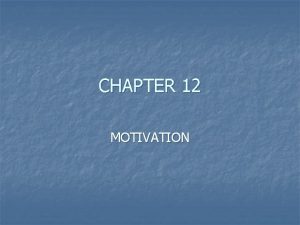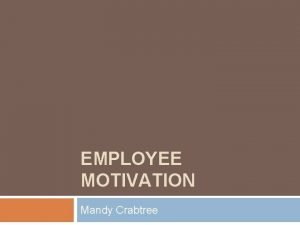Chapter 17 Motivation 1 What Is Motivation Motivation












- Slides: 12

Chapter 17 Motivation 1

What Is Motivation? Motivation ◦ The processes that account for an individual’s willingness to exert high levels of effort to reach organizational goals, conditioned by the effort’s ability to satisfy some individual need Effort: a measure of intensity or drive Direction: toward organizational goals Need: personalized reason to exert effort ◦ Motivation works best when individual needs are compatible with organizational goals 2

The Motivation Process Unsatisfied Need Tension Effort Satisfied Need Tension Reduction • Intensity • Direction • Persistence 3

Early Theories of Motivation Maslow’s Hierarchy of Needs Theory ◦ Needs were categorized as five levels Individuals must satisfy lower-order needs before they can satisfy higher order needs Satisfied needs will no longer motivate Motivating a person depends on knowing at what level that person is on the hierarchy ◦ Hierarchy of needs Lower-order (external): physiological, safety Higher-order (internal): social, esteem, selfactualization 4

Maslow’s Hierarchy of Needs Self. Actualization Esteem Social Safety Physiological 5

Early Theories of Motivation (cont’d) Herzberg’s Motivation-hygiene Theory ◦ Job satisfaction and job dissatisfaction are created by different factors Hygiene factors: extrinsic (environmental) factors that create job dissatisfaction Motivators: intrinsic (psychological) factors that create job satisfaction ◦ Attempted to explain why job satisfaction does not result in increased performance The opposite of satisfaction is not dissatisfaction, but rather no satisfaction 6

Herzberg’s Motivation-Hygiene Theory Motivators • • • Hygiene Factors Achievement Recognition Work Itself Responsibility Advancement Growth Extremely Satisfied • Supervision • Company Policy • Relationship with Supervisor • Working Conditions • Salary • Relationship with Peers • Personal Life • Relationship with Subordinates • Status • Security Neutral Extremely Dissatisfied 7

Contrasting Views of Satisfaction– Dissatisfaction Traditional View Satisfied Dissatisfied Herzberg’s View Motivators Satisfaction No Satisfaction Hygiene Factors No Dissatisfaction 8

Motivation and Perception Equity Theory ◦ Proposes that employees perceive what they get from a job situation (outcomes) in relation to what they put in (inputs) and then compare their inputsoutcomes ratio with the inputs-outcomes ratios of relevant others If the ratios are perceived as equal then a state of equity (fairness) exists If the ratios are perceived as unequal, inequity exists and the person feels under- or over-rewarded When inequities occur, employees will attempt to do something to rebalance the ratios (seek justice) 9

Motivation and Perception (cont’d) Equity Theory (cont’d) ◦ Employee responses to perceived inequities: Distort own or others’ ratios Induce others to change their own inputs or outcomes Change own inputs (increase or decrease efforts) or outcomes (seek greater rewards) Choose a different comparison (referent) other (person, systems, or self) Quit their job ◦ Employees are concerned with both the absolute and relative nature of organizational rewards 1 0

Equity Theory Ratio of Output to Input Person 1’ s Perception Person 1 Person 2 Inequity, under-rewarded Person 1 Equity Person 2 Person 1 Inequity, over-rewarded Person 2 1 1

Motivation and Perception (cont’d) Equity Theory (cont’d) ◦ Distributive Justice The perceived fairness of the amount and allocation of rewards among individuals (i. e. , who received what) Influences an employee’s satisfaction ◦ Procedural Justice The perceived fairness of the process used to determine the distribution of rewards (i. e. , how who received what) Affects an employee’s organizational commitment 1 2
 Cognitive appraisal psychology definition
Cognitive appraisal psychology definition Chapter 13 motivation and emotion
Chapter 13 motivation and emotion Chapter 12 motivation and emotion
Chapter 12 motivation and emotion Chapter 7 organizational behavior
Chapter 7 organizational behavior Chapter 9 motivation and emotion quiz
Chapter 9 motivation and emotion quiz Paul ekman universal facial expressions
Paul ekman universal facial expressions Chapter 3 discovering self motivation quiz
Chapter 3 discovering self motivation quiz Display rules psychology
Display rules psychology Motivation chapter
Motivation chapter Chapter 10 motivation and emotion
Chapter 10 motivation and emotion Chapter 8 motivation and emotion
Chapter 8 motivation and emotion Incentive theory ap psychology
Incentive theory ap psychology Hypothetical dailymotion
Hypothetical dailymotion

